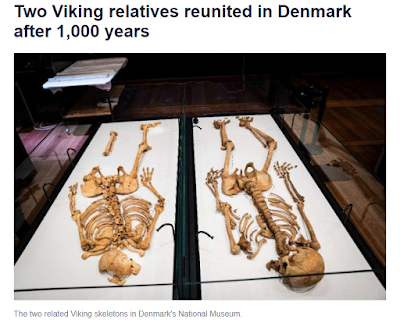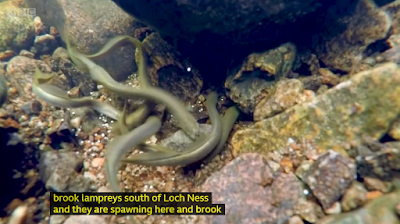A quiet day with the highlight being a cup of coffee and a biscuit on the patio mid-morning, which speaks volumes. Oh dear!
we enjoy a coffee and a biscuit on the patio mid-morning
A quiet day here for us, which gives me a chance to look at my smartphone. And what a fizzer of a week it's been outside the immediate area of our house!
Story no. 1 is that two Viking relatives, both warriors, have at last been reunited in Denmark after 1000 years of anguished separation, which is good news, a real "human interest" story at last!
One of the men died, of head injuries, in Oxford in the 11th century - he was in his 20's. The other man, shown to be a relative by DNA evidence, died in Denmark in his 50's: it's not known what he died of, but he was probably a warrior because he sustained several blows to his head in the course of what must have been a "promising career" as a middle-aged Viking. It's almost unknown for two skeletons found hundreds of miles apart to be shown to be related - my god! Isn't genetics wonderful !
Story no.2 is about dinosaurs in flight. I reported in my blog earlier this week that scientists now believe dinosaurs looked much more like birds that we used to think. Many popular "reconstructions" of what dinosaurs looked like, for example in the Jurassic Park films, have been shown in recent years to be quite inaccurate, mainly because it was not realised to what extent many species were feathered.
flashback to my blog of earlier this week
I read today in the Smithsonian Magazine, that dinosaurs actually evolved flight three times, and that many dinosaur species were far more aerodynamic than had previously been thought. So flight is not such a rare feature in nature as was once believed.
According to the article, the raptor-like ancestors of birds split off from their
closest dinosaur relatives during the Jurassic, about 150 million years ago,
and were just another part of the Age of Dinosaurs. But when an asteroid strike
sparked a mass extinction 66 million years ago, beaked birds were the only dinosaurs
to survive the catastrophe and carry on the legacy of the “terrible lizards” to
the present day.
I don't know - what a crazy planet we live on !!!!!
16:00 Lois and I enjoy a cup of Earl Grey and a piece of bread and jam on the couch. We listen to the radio, an interesting programme called "The Last Word". We try and catch this programme every Friday afternoon to find out whether anyone has died this week or not.
Sadly, the American folk-singer Alix Dobkin has died, aged 80. A gay activist, she wrote many songs, one of which, "View from Gay Head", has the distinction, among other things, of including the word "lesbian" a record number of times - it'll probably be a long time before this record is broken, we think!
One verse goes:
Is Alix's achievement in the Guinness Book of Records? I don't know, but I think we should be told!
17:30 We have dinner, earlier than usual, because at 6pm there's another talk we want to watch from the York Festival of Ideas, all about the Great Army of Vikings that spent about 10 years in England in the 9th century. The talk is being given on zoom by husband-and-wife professorial team Julian Richards and Dawn Hadley.
For years the massive "Great Army" (the "micel here" in Anglo-Saxon) was a bit of a mystery to modern historians and archaeologists. Where were the traces of it?
For years a D-shaped camp-site in Lincolnshire, at Torksey Island, seemed to be the only place where archaeologists could find traces of an Viking army camp-site, but the site seemed too small. only 0.4 hectares whatever that means [It's about 1 acre - Ed]. That is, only a 6th of the size of our daughter Alison's garden in Hampshire.
What madness !!!! Not so much a "great army" as a "teeny-weeny army".
Eventually, however, archaeologists found the real site at Torksey Island where the Vikings spent their first winter, much larger, at 55 hectares or 136 acres, and after that, they knew what they were looking for. And hey presto, archaeologists were soon finding other similar sites all over England.


There's no doubt that the presence of the Great Army for those 10 years, together with further Danish settlement in the east of England kick-started English modernisation in many fields:
1. the consolidation of the many Anglo-Saxon kingdoms into one big one.
2. establishment of the Danelaw jurisdiction in the east of the country
3. the first appearance of real towns since the Romans had left
4. the development of early industries: metal working, pottery etc, sometimes called our first Industrial Revolution.
5. development of private ownership of land: previously all land had belonged either to the Crown or to the Church.
It's interesting that many of the soldiers in the Great Army weren't from Scandinavia but from the Low Countries and other areas of northern Europe where the army had been rampaging about before they came to England, so these were guys they had "picked up" along the way - including skilled potters, metal-workers etc.
Fascinating stuff !!!!
Both Lois and I notice how much Julian Richards has aged, and how he has become so much more professorial and magisterial, compared to the good old days when he was tramping about fields in Wellington boots, doing real digging.
Julian Richards in happier times - digging up Stonehenge
Poor Julian !!!!!
20:00 A phone call from Felicity, our daughter Alison's mother-in-law, and after that we settle down to watch a bit of TV, another edition of Springwatch, that surveys wild life in the UK through a group of resident presenters and a network of hidden cameras.
Fascinating tonight to see some 6 inch long brook-lampreys spawning up in Scotland, somewhere near Loch Ness. When the temperature reaches about 50F (10C) they make their way up little streams to spawn. They find a suitable place, move any annoying bigger rocks out of the way, to create a "redd" or nest, and then get down to it.
The female latches on to one of the bigger rocks, and then vibrates. This stimulates the males to hang on to her, and squeeze her, so that all her eggs come out, and then they fertilise the eggs. Simples!
The female will lay up to 1500 eggs, and after the process is all over, all the adults simply die - oh dear, poor lampreys!! A bit of a sad end, but I suppose they must enjoy it, or they wouldn't do it!
Not content with dying themselves, some medieval lampreys, after they had died themselves, later killed poor King John (1199-1216). He famously died of a surfeit of them, only a year after signing the Magna Carta.
Poor John !!!!!! And naughty dead lampreys !!!!
What a crazy planet we live on !!!!!!!
22:00 We go to bed - zzzzzz!!!


















No comments:
Post a Comment